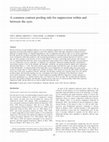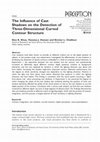Papers by Kirsten Challinor
It is clear that masking from parallel surrounds (doughnuts) and superimposed orthogonal masks in... more It is clear that masking from parallel surrounds (doughnuts) and superimposed orthogonal masks involves different processes, but detailed comparisons have not been made. We measured contrast-masking functions for target patches of grating (1.25 cycles, 1 cycle ...
i-Perception, 2012
Variations of perceived speed with spatial frequency (SF), temporal frequency (TF), and contrast ... more Variations of perceived speed with spatial frequency (SF), temporal frequency (TF), and contrast have been known for many years. However, these effects have largely been studied in isolation, preventing comparison of the perceived speed of stimuli across the spatiotemporal frequency surface. We present the first systematic study to establish the perceived speed of high-and low-contrast (70% and 7%) stimuli across a broad range of Fourier parameters (SFs from 0.25-8c/deg; TFs from 2-16Hz; speeds from 0.25–64deg/s). ...

Optometry and vision science : official publication of the American Academy of Optometry, Jan 17, 2015
Evidence-based practice (EBP) is an essential component of good quality, patient-centered health ... more Evidence-based practice (EBP) is an essential component of good quality, patient-centered health care. This requires practitioners to acquire EBP skills and knowledge during undergraduate and continuing education. Evidence-based practice education exists in a range of health care disciplines, including optometry. Evidence-based practice education, however, depends on relevant skills and knowledge in educators. Courses and workshops exist for the development of EBP teaching skills in some areas of health care but not in optometry. Here, we describe a pilot workshop designed to enhance the teaching of EBP and to investigate the perspectives of optometric educators on EBP including their attitudes and perceived barriers to EBP and its teaching. Twenty-seven optometric educators including 8 facilitators participated. Of these, 14 were academics (including the 8 facilitators) and 13 were practitioners. Evidence-based practice attitudes were assessed using the Evidence-Based Practice Atti...
i-Perception, 2012
Variations of perceived speed with spatial frequency (SF), temporal frequency (TF), and contrast ... more Variations of perceived speed with spatial frequency (SF), temporal frequency (TF), and contrast have been known for many years. However, these effects have largely been studied in isolation, preventing comparison of the perceived speed of stimuli across the spatiotemporal frequency surface. We present the first systematic study to establish the perceived speed of high-and low-contrast (70% and 7%) stimuli across a broad range of Fourier parameters (SFs from 0.25-8c/deg; TFs from 2-16Hz; speeds from 0.25–64deg/s). ...
Applied Vision Association Annual 2009 Meeting, 2009
Over the last ten years our understanding of early spatial vision has improved enormously. The lo... more Over the last ten years our understanding of early spatial vision has improved enormously. The long-standing model of probability summation amongst multiple independent mechanisms with static output nonlinearities responsible for masking is obsolete. It has been replaced by a much more complex network of additive, suppressive, and facilitatory interactions and nonlinearities across eyes, area, spatial frequency, and orientation that extend well beyond the classical recep-tive field (CRF). A review of a substantial body of ...
Description Bayesian models of motion perception propose that human perception of velocity is inf... more Description Bayesian models of motion perception propose that human perception of velocity is influenced both by signals from the stimulus and by a prior preference for stationarity. When velocity signals from the stimulus show little uncertainty, the prior has little effect, but as uncertainty is increased the prior exerts a greater influence, causing a more substantial reduction in the magnitude of perceived velocity. This model can successfully account for several illusions of perceived direction (Weiss et al, 2002 Nature ...

In two-stroke apparent movement, repeated presentation of a two-frame pattern displacement follow... more In two-stroke apparent movement, repeated presentation of a two-frame pattern displacement followed by a brief inter-stimulus interval (ISI) can create an impression of continuous forward motion . Does the ISI in two-stroke motion just break the connection between adjacent frames, switching off the motion signal they normally generate, or does it actually generate a reversed motion signal? Reversed apparent motion in two-frame stimuli separated by a brief ISI has been reported in several previous papers (ISI reversal), which found that the effect is optimal at short, mean-luminance ISIs, and is abolished at scotopic luminances. A series of five experiments compared two-stroke apparent motion with ISI reversal using the same stimulus display. The two effects show the same dependence on ISI duration and luminance and are both abolished at low mean luminance. Results therefore support the conclusion that the ISI in twostroke apparent motion does contribute a reversed motion signal and constrain theoretical explanations of two-stroke apparent motion.
Macquarie University ResearchOnline.

Vision research, Jan 1, 2010
Two-stroke apparent motion offers a challenge to current theoretical models of motion processing ... more Two-stroke apparent motion offers a challenge to current theoretical models of motion processing and is thus a useful tool for investigating motion sensor input. The stimulus involves repeated presentation of two pattern frames containing a spatial displacement, with a blank inter-stimulus interval (ISI) at one of the two-frame transitions. The resulting impression of continuous motion was measured here using both direction discrimination and motion after-effect duration in order to assess the extent to which data using the two measures can be explained by a computational model without reference to attentive tracking mechanisms. The motion-energy model was found to offer a very good account of the psychophysical data using similar parameters for both tasks. The experiment was run under both photopic and scotopic retinal illumination. Data revealed that the optimum ISI for perceiving two-stroke apparent motion shifts to longer ISIs under scotopic conditions, providing evidence for a biphasic impulse response at low luminance. Best-fitting model parameters indicate that motion sensors receive inputs from temporal filters whose central temporal frequency shifts from 2.5 to 3.0 Hz at high retinal illuminance to 1.0–1.5 Hz at low retinal illuminance.
Perception, Jan 1, 2007
It is clear that masking from parallel surrounds (doughnuts) and superimposed orthogonal masks in... more It is clear that masking from parallel surrounds (doughnuts) and superimposed orthogonal masks involves different processes, but detailed comparisons have not been made. We measured contrast-masking functions for target patches of grating (1.25 cycles, 1 cycle ...

Vision research, Jan 1, 2007
To explore spatial interactions between visual mechanisms in the Fourier domain we measured detec... more To explore spatial interactions between visual mechanisms in the Fourier domain we measured detection thresholds for vertical and horizontal sine-wave gratings (4.4 deg diameter) over a range of spatial frequencies (0.5-23 c/deg) in the presence of grating and plaid masks with component contrasts of 8%, orientations of §45° and a spatial frequency of 1 c/deg. The mask suppressed the target grating over a range of §1 octave, and the plaid produced more suppression than the grating, consistent with summation of mask components in a broadly tuned contrast gain pool. At greater diVerences in spatial frequency (»3 octaves), the plaid and grating masks both produced about 3 dB of facilitation (they reduced detection thresholds by a factor of about F2). At yet further distances (»4 octaves) the masks had no eVect. The facilitation cannot be attributed to a reduction of uncertainty by the mask because (a) it occurs for mask components that have very diVerent spatial frequencies and orientations from the test and (b) the large stimulus size and central Wxation point mean there was no spatial uncertainty that could be reduced. We suggest the results are due to long-range sensory interactions (in the Fourier domain) between mask and test-channels. The eVects could be due to either direct facilitation or disinhibition.
Vision research, Jan 1, 2009
The user has requested enhancement of the downloaded file. All in-text references underlined in b... more The user has requested enhancement of the downloaded file. All in-text references underlined in blue are added to the original document and are linked to publications on ResearchGate, letting you access and read them immediately. This article appeared in a journal published by Elsevier. The attached copy is furnished to the author for internal non-commercial research and education use, including for instruction at the authors institution and sharing with colleagues.

Journal of vision, Jan 1, 2009
In two-stroke apparent movement, repeated presentation of a two-frame pattern displacement follow... more In two-stroke apparent movement, repeated presentation of a two-frame pattern displacement followed by a brief inter-stimulus interval (ISI) can create an impression of continuous forward motion . Does the ISI in two-stroke motion just break the connection between adjacent frames, switching off the motion signal they normally generate, or does it actually generate a reversed motion signal? Reversed apparent motion in two-frame stimuli separated by a brief ISI has been reported in several previous papers (ISI reversal), which found that the effect is optimal at short, mean-luminance ISIs, and is abolished at scotopic luminances. A series of five experiments compared two-stroke apparent motion with ISI reversal using the same stimulus display. The two effects show the same dependence on ISI duration and luminance and are both abolished at low mean luminance. Results therefore support the conclusion that the ISI in twostroke apparent motion does contribute a reversed motion signal and constrain theoretical explanations of two-stroke apparent motion.

Visual neuroscience, Jan 1, 2008
Recent work has revealed multiple pathways for cross-orientation suppression in cat and human vis... more Recent work has revealed multiple pathways for cross-orientation suppression in cat and human vision. In particular, ipsiocular and interocular pathways appear to assert their influence before binocular summation in human but have different (1) spatial tuning, (2) temporal dependencies, and (3) adaptation after-effects. Here we use mask components that fall outside the excitatory passband of the detecting mechanism to investigate the rules for pooling multiple mask components within these pathways. We measured psychophysical contrast masking functions for vertical 1 cycle/ deg sine-wave gratings in the presence of left or right oblique (645 deg) 3 cycles/deg mask gratings with contrast C%, or a plaid made from their sum, where each component (i) had contrast 0.5C i %. Masks and targets were presented to two eyes (binocular), one eye (monoptic), or different eyes (dichoptic). Binocular-masking functions superimposed when plotted against C, but in the monoptic and dichoptic conditions, the grating produced slightly more suppression than the plaid when C i $ 16%. We tested contrast gain control models involving two types of contrast combination on the denominator: (1) spatial pooling of the mask after a local nonlinearity (to calculate either root mean square contrast or energy) and (2) ''linear suppression'' , Journal of Vision 4, 1080-1089, involving the linear sum of the mask component contrasts. Monoptic and dichoptic masking were typically better fit by the spatial pooling models, but binocular masking was not: it demanded strict linear summation of the Michelson contrast across mask orientation. Another scheme, in which suppressive pooling followed compressive contrast responses to the mask components (e.g., oriented cortical cells), was ruled out by all of our data. We conclude that the different processes that underlie monoptic and dichoptic masking use the same type of contrast pooling within their respective suppressive fields, but the effects do not sum to predict the binocular case.
Journal Articles by Kirsten Challinor

Cast shadows have been shown to provide an effective ordinal cue to the depth position of objects... more Cast shadows have been shown to provide an effective ordinal cue to the depth position of objects. In the present study, two experiments investigated the effectiveness of cast shadows in facilitating the detection of spatial contours embedded in a field of randomly placed elements. In Experiment 1, the separation between the cast shadow and the contour was systematically increased to effectively signal different contour depth positions (relative to background elements), and this was repeated for patterns in which the lighting direction was above and from below. Increasing the shadow separation improved contour detection performance, but the degree to which sensitivity changed was dependent on the lighting direction. Patterns in which the light was from above were better detected than patterns in which the lighting direction was from below. This finding is consistent with the visual system assuming a ''light-from-above rule'' when processing cast shadows. In Experiment 2, we examined the degree to which changing the shape of the cast shadow (by randomly jittering the position of local cast shadow elements) affected the ability of the visual system to rely on the cast shadow to cue the depth position of the contour. Consistent with a coarse scale analysis, we find that cast shadows remained an effective depth cue even at large degrees of element jitter. Our findings demonstrate that cast shadows provide an effective means of signaling depth, which aids the process of contour integration, and this process is largely tolerant of local variations in lighting direction.

Although body size and shape misperception (BSSM) is a common feature of anorexia nervosa, bulimi... more Although body size and shape misperception (BSSM) is a common feature of anorexia nervosa, bulimia nervosa and muscle dysmorphia, little is known about its underlying neural mechanisms. Recently, a new approach has emerged, based on the long-established non-invasive technique of perceptual adaptation, which allows for inferences about the structure of the neural apparatus responsible for alterations in visual appearance. Here, we describe several recent experimental examples of BSSM, wherein exposure to " extreme " body stimuli causes visual aftereffects of biased perception. The implications of these studies for our understanding of the neural and cognitive representation of human bodies, along with their implications for clinical practice are discussed. Creative Commons Non Commercial CC-BY-NC: This article is distributed under the terms of the Creative Commons Attribution-NonCommercial 4.0 License (http://www.creativecommons.org/licenses/by-nc/4.0/) which permits non-commercial use, reproduction and distribution of the work without further permission provided the original work is attributed as specified on the SAGE and Open Access pages (https://us.sagepub.com/en-us/nam/open-access-at-sage).
Suttle CM; Challinor KL; Thompson RE; Pesudovs K; Togher L; Chiavaroli N; Lee A; Junghans B; Stap... more Suttle CM; Challinor KL; Thompson RE; Pesudovs K; Togher L; Chiavaroli N; Lee A; Junghans B; Stapleton F; Watt K; Jalbert I, 2015, 'Attitudes and barriers to evidence-based practice in optometry educators.', Optometry and Vision Science, vol. 92, no. 4, pp. 514 - 523


Uploads
Papers by Kirsten Challinor
Journal Articles by Kirsten Challinor